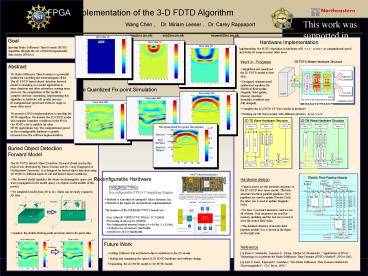FPGA Implementation of the 3-D FDTD Algorithm PowerPoint PPT Presentation
Title: FPGA Implementation of the 3-D FDTD Algorithm
1
FPGA Implementation of the 3-D FDTD Algorithm
This work was supported in part by CenSSIS, the
Center for Subsurface Sensing and Imaging
Systems, under the Engineering Research Centers
Program of the National Science Foundation (Award
Number EEC-9986821).
Wang Chen , Dr. Miriam Leeser , Dr. Carey
Rappaport wchen_at_ece.neu.edu
mel_at_ece.neu.edu
rappaport_at_ece.neu.edu
Hardware Implementation
Implementing the FDTD Algorithm in hardware will
greatly increase its computational speed and
widen its usage in many other areas.
Work in Progress
2D FDTD Model Hardware Structure
- Simplified and Quantized the 2D FDTD model as
first step. - Designed, simulated and synthesized modules for
Electrical field update, Magnetic field update,
Memory interface Boundary condition and Full
datapath.
The Quantized Fix-point Simulation
- Complete the 2D FDTD TE Wave model in hardware.
- Working on TM Wave model, with different
structure shown below.
Reconfigurable Hardware
Hardware design
- Figures above are the hardware structure of the
2D FDTD Free space model. The basic structure has
three parallel pipelines. Two pipelines are used
to update Electric Field, the other one is used
to update Magnetic Field. - We have 5 on-board memories and we use all of
them. Four memories are used for memory updating
and the last one is used to store the source
field value. - The detailed structure of electric field
pipeline module Exs is shown in the figure on the
right side.
Future Work
Reference
- Adding Different Soil and buried object
conditions to the 2D Model. - Testing and comparing the speed of 2D FDTD
hardware and software design. - Expanding the 2D FDTD model to 3D FDTD model.
1 Ryan N. Schneider, Laurence E. Turner, Michal
M.Okoniewski, Application of FPGA Technology to
Accelerate the Finite-Difference Time-Domain
(FDTD) Method, FPGA 2002. 2 Karl S. Kunz,
Raymond J. Luebbers, The Finite Difference Time
Domain Method for Electromagnetics, CRC Press,
1993."
PowerShow.com is a leading presentation sharing website. It has millions of presentations already uploaded and available with 1,000s more being uploaded by its users every day. Whatever your area of interest, here you’ll be able to find and view presentations you’ll love and possibly download. And, best of all, it is completely free and easy to use.
You might even have a presentation you’d like to share with others. If so, just upload it to PowerShow.com. We’ll convert it to an HTML5 slideshow that includes all the media types you’ve already added: audio, video, music, pictures, animations and transition effects. Then you can share it with your target audience as well as PowerShow.com’s millions of monthly visitors. And, again, it’s all free.
About the Developers
PowerShow.com is brought to you by CrystalGraphics, the award-winning developer and market-leading publisher of rich-media enhancement products for presentations. Our product offerings include millions of PowerPoint templates, diagrams, animated 3D characters and more.

